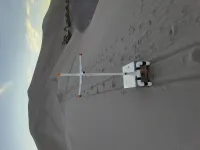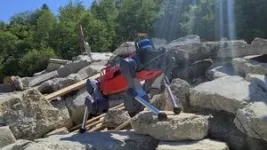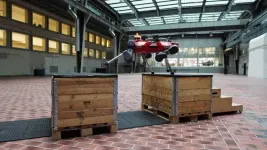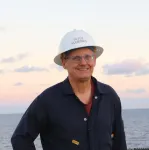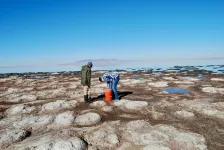(Press-News.org) SAN ANTONIO — March 13, 2024 —Southwest Research Institute (SwRI) has been awarded a three-year, $2,041,000 grant from NASA’s Development and Advancement of Lunar Instrumentation (DALI) program to further develop a novel ground-penetrating radar instrument. The Synthetic Pulse Artemis Radar for Crustal Imaging (SPARCI, pronounced “sparky”) instrument is designed to characterize the depth of the regolith and upper megaregolith, the upper broken-up layers of lunar crust associated with impact cratering.
SwRI is one of five teams awarded funding by NASA’s DALI program, which supports the development of instruments for future lunar missions, including Commercial Lunar Payload Services and Artemis. DALI’s goal is to develop and demonstrate instruments that are technically ready to propose for upcoming flight opportunities. These instruments must demonstrate new technologies that significantly improve instrument measurement capabilities for addressing high-priority lunar science questions.
When astronauts return to the Moon during the second half of this decade their tasks will include deploying lunar instruments and using new technology to characterize the Moon. SPARCI’s two large transmitting antennas that are 172 and 40 meters in length are designed to be deployed by astronauts. A robotic rover with much smaller antennas will then receive radar signals that penetrate the Moon’s subsurface. The ground-penetrating radar will measure the thickness and structure of the lunar megaregolith. Believed to be between 0.4 and 5 kilometers deep, the megaregolith formed just after the Moon solidified and likely experienced heavy bombardment from other objects during the early formation of the solar system.
“Learning more about the lunar megaregolith will help us gain a wider understanding of the Moon’s formation and that of similar bodies with thin, sparse atmospheres,” said SwRI’s Dr. David Stillman, the project’s principal investigator. “If we are able to pinpoint exactly where this layer begins, we can use that to create more accurate formation and evolution models.”
SPARCI’s design was inspired by Apollo 17’s Surface Electrical Properties (SEP) experiment, which collected subsurface data on the Moon while attached to the Lunar Roving Vehicle. Like SEP, SPARCI uses two stationary transmitting antennas and a mobile receiver but attached to a robotic rover instead of an astronaut-driven vehicle.
“SPARCI uses much wider bandwidth and electronics that are 50 years more advanced than the SEP, enabling both deeper and higher-resolution imaging,” Stillman said. “SPARCI will determine the thickness and density of the overall regolith, measuring the structure of the upper megaregolith and the depth of the lower regolith. This information will help advance understanding of impact processes on the Moon and other bodies that don’t have significant atmospheres. If we can pinpoint exactly where this layer below the landing site, we can use other global datasets to better constrain the structure of the megaregolith globally.”
For more information, visit https://www.swri.org/planetary-science.
END
SwRI receives $2 million NASA grant to develop lunar-regolith-measuring instrument
SPARCI instrument to make the first measurements of the Moon’s megaregolith
2024-03-13
ELSE PRESS RELEASES FROM THIS DATE:
ANYmal can do parkour and walk across rubble
2024-03-13
ANYmal has for some time had no problem coping with the stony terrain of Swiss hiking trails. Now researchers at ETH Zurich have taught this quadrupedal robot some new skills: it is proving rather adept at parkour, a sport based on using athletic manoeuvres to smoothly negotiate obstacles in an urban environment, which has become very popular. ANYmal is also proficient at dealing with the tricky terrain commonly found on building sites or in disaster areas.
To teach ANYmal these new skills, two teams, both from the group led by ETH Professor Marco Hutter of the Department of Mechanical and Process Engineering, followed different approaches.
Exhausting the mechanical options
Working ...
Scientists unravel mystery of drug response in small cell lung cancer
2024-03-13
Small cell lung cancer (SCLC) is a highly aggressive tumour of the lung that occurs especially in heavy smokers. Due to the rapid spread of this tumour type, most patients can only be treated with chemotherapy with remarkable initial anti-tumour efficacy. However, relapse often occurs over the course of time. A research team at the University of Cologne led by Professor Dr Roman Thomas, director of the Department of Translational Genomics and speaker of the Collaborative Research Center 1399 (CRC 1399, ...
Peter Flemings wins Robert R. Berg Outstanding Research Award
2024-03-13
Jackson School of Geosciences Professor Peter Flemings is the recipient of the 2024 Robert R. Berg Outstanding Research Award, a top honor bestowed by the American Association of Petroleum Geologists, a worldwide professional association.
Over the course of his career, Flemings has worked to apply his academic research to effect real-world breakthroughs. His work analyzing how pressure within Earth’s crust is controlled by geology and fluid flow, for example, shaped how oil companies now safely search for hydrocarbons.
Flemings and his students explored how the evolution of rock layers controls the flow of fluids within them and the distribution ...
Study shows important role gut microbes play in airway health in persons with cystic fibrosis
2024-03-13
Findings from a new study conducted by a team of researchers at Dartmouth’s Geisel School of Medicine and published in the journal mBio, reflect the important role that the gut microbiome (communities of bacteria) plays in the airway health of persons with cystic fibrosis.
Cystic fibrosis is an inherited disease that causes sticky, thick mucus to build up in the lungs and other organs, causing persistent infections that can be deadly. Until relatively recently, CF microbiology research has largely ...
With discovery of roundworms, Great Salt Lake’s imperiled ecosystem gets more interesting
2024-03-13
Scientists have long suspected nematodes, commonly known as roundworms, inhabit Utah’s Great Salt Lake sediments, but until recently, no one had actually recovered any there.
It took a University of Utah postdoc with a hammer and loads of field experience to solve the puzzle. Along with biology professor Michael Werner, postdoctoral researcher Julie Jung announced in a study published March 13 that they discovered thousands of tiny worms in the lake’s microbialites, those reef-like structures that cover about a fifth of the lakebed.
Their initial attempts failed to find nematodes in lakebed sediments, prompting Jung to take a hammer to samples ...
Most consumers continue to expect rising food prices
2024-03-13
Most U.S. consumers surveyed in February 2024 predicted that they would see an increase in food prices over the next 12 months. Sixty-four percent of respondents predict food prices to rise in the next year, and the average predicted increase is 3.7%, according to the February Consumer Food Insights Report.
The survey-based report out of Purdue University’s Center for Food Demand Analysis and Sustainability assesses food spending, consumer satisfaction and values, support of agricultural and food policies and trust in information sources. Purdue experts conducted and evaluated the survey, which ...
Innovative approaches for addressing difficult topics in K-12 schools
2024-03-13
UNIVERSITY PARK, Pa. — Three peer-reviewed journals have recently published research papers by Penn State’s Hammel Family Human Rights Initiative. The papers illustrate how the initiative’s programs help K-12 educators address difficult issues such as racism.
The three journals that published the initiative papers are School-University Partnerships, Journal of Practitioner Research and Journal of Teacher Education. JTE, as it’s known, is widely considered the top-ranked research journal in the field of teacher education. Some of the scholars who independently ...
Methane emissions from U.S. oil and gas operations cost the nation $10 billion per year
2024-03-13
Oil and gas operations across the United States are emitting more than 6 million tons per year of methane, the main component of natural gas and the most abundant greenhouse gas after carbon dioxide, according to Stanford-led research published March 13 in Nature.
These emissions, which result from both intentional vents and unintentional leaks, amount to $1 billion in lost commercial value for energy producers. The annual cost rises to $10 billion when researchers account for harm to the economy and human well-being caused by adding this amount of heat-trapping methane ...
Explaining a supernova's 'string of pearls'
2024-03-13
Images
Physicists often turn to the Rayleigh-Taylor instability to explain why fluid structures form in plasmas, but that may not be the full story when it comes to the ring of hydrogen clumps around supernova 1987A, research from the University of Michigan suggests.
In a study published in Physical Review Letters, the team argues that the Crow instability does a better job of explaining the "string of pearls" encircling the remnant of the star, shedding light on a longstanding astrophysical mystery.
"The fascinating ...
Marine heat waves disrupt the ocean food web in the northeast Pacific Ocean
2024-03-13
NEWPORT, Ore. – Marine heat waves in the northeast Pacific Ocean create ongoing and complex disruptions of the ocean food web that may benefit some species but threaten the future of many others, a new study has shown.
The study, just published in the journal Nature Communications, is the first of its kind to examine the impacts of marine heat waves on the entire ocean ecosystem in the northern California Current, the span of waters along the West Coast from Washington to Northern California.
The researchers found that the biggest beneficiary of marine heat waves is gelatinous zooplankton – predominantly ...
LAST 30 PRESS RELEASES:
New study shows how the spleen helps the immune system accept a transplant
New Mayo Clinic study advances personalized prostate cancer education with an EHR-integrated AI agent
Researchers identify novel therapeutic target to improve recovery after nerve injury
Microbes in breast milk help populate infant gut microbiomes
Reprogramming immunity to rewrite the story of Type 1 diabetes
New tool narrows the search for ideal material structures
Artificial saliva containing sugarcane protein helps protect the teeth of patients with head and neck cancer
Understanding the role of linear ubiquitination in T-tubule biogenesis
Researchers identify urban atmosphere as primary reservoir of microplastics
World’s oldest arrow poison – 60,000-year-old traces reveal early advanced hunting techniques
Bristol scientists discover early sponges were soft
New study uncovers how rice viruses manipulate plant defenses to protect insect vectors
NSF–DOE Vera C. Rubin Observatory spots record-breaking asteroid in pre-survey observations
Ribosomal engineering creates “super-probiotic” bacteria
This self-powered eye tracker harnesses energy from blinking and is as comfortable as everyday glasses
Adverse prenatal exposures linked to higher rates of mental health issues, brain changes in adolescents
Restoring mitochondria shows promise for treating chronic nerve pain
Nature study identifies a molecular switch that controls transitions between single-celled and multicellular forms
USU chemists' CRISPR discovery could lead to single diagnostic test for COVID, flu, RSV
Early hominins from Morocco reveal an African lineage near the root of Homo sapiens
Small chimps, big risks: What chimps show us about our own behavior
We finally know how the most common types of planets are created
Thirty-year risk of cardiovascular disease among healthy women according to clinical thresholds of lipoprotein(a)
Yoga for opioid withdrawal and autonomic regulation
Gene therapy ‘switch’ may offer non-addictive pain relief
Study shows your genes determine how fast your DNA mutates with age
Common brain parasite can infect your immune cells. Here's why that's probably OK
International experts connect infections and aging through cellular senescence
An AI–DFT integrated framework accelerates materials discovery and design
Twist to reshape, shift to transform: Bilayer structure enables multifunctional imaging
[Press-News.org] SwRI receives $2 million NASA grant to develop lunar-regolith-measuring instrumentSPARCI instrument to make the first measurements of the Moon’s megaregolith
